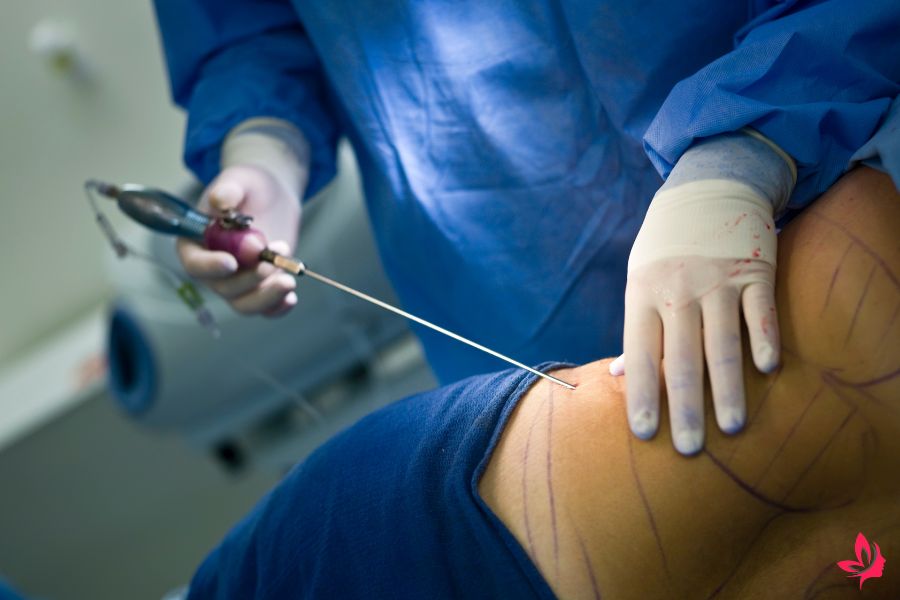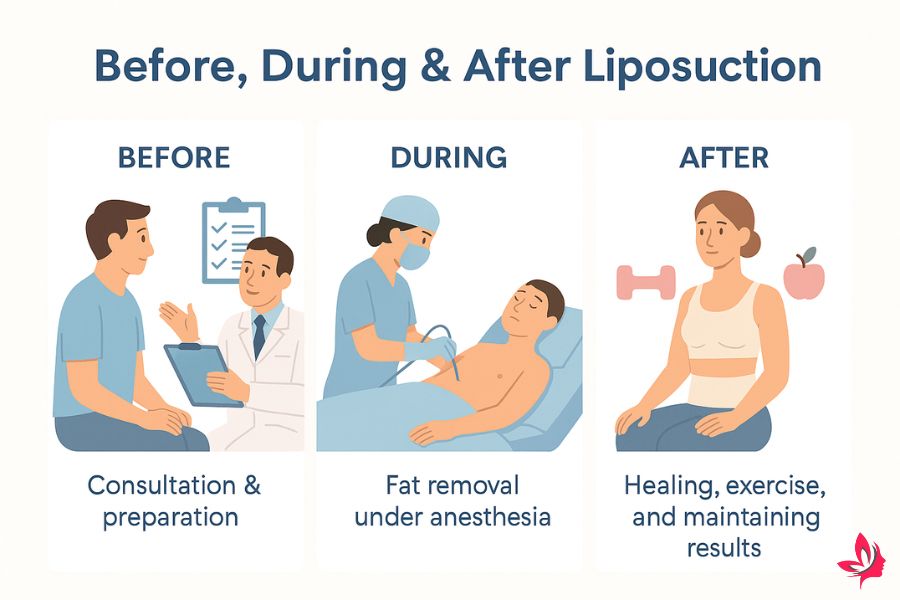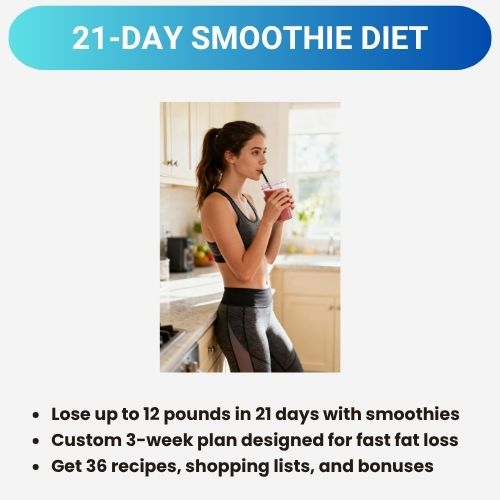Do you lose weight with liposuction? That question often trips up people who view this procedure as a shortcut to losing weight.
Liposuction typically removes between two and five pounds of fat. It’s meant for shaping your body, not for big weight loss.
Many people go into liposuction expecting dramatic weight loss. The reality? The surgery targets those annoying fat pockets that won’t budge with diet or exercise, but it can’t replace healthy lifestyle habits for long-term weight management.
Knowing what liposuction does—and doesn’t—do can save you a lot of disappointment. Let’s delve into how the procedure works, what recovery looks like, and why you can’t skip good nutrition and exercise if you want results to last.
Understanding Liposuction as a Body Contouring Procedure, Not a Weight Loss Method

Do you lose weight with liposuction? That confusion is everywhere.
Liposuction is a body contouring procedure designed to remove localized fat deposits, not a weight loss solution.
The Common Misconception About Liposuction and Weight Loss
Many people believe liposuction is their ticket to a lower number on the scale. It’s easy to see why, but that’s not how it works.
Liposuction is not a weight loss method but a body contouring procedure. Its main job is to reshape specific body areas, rather than helping you lose a significant amount of weight.
If you expect to lose a lot of weight from liposuction, you’ll probably feel let down. The best candidates understand that it’s for those stubborn spots that won’t go away, regardless of how healthy their diet is or how often they exercise.
A board-certified surgeon will tell you straight-up: the procedure removes only a few pounds of fat from targeted spots. Usually, that’s anywhere from 2 to 10 pounds, depending on the area.
How the Liposuction Procedure Actually Works on Subcutaneous Fat
Liposuction removes subcutaneous fat through small incisions with a thin tube called a cannula. Traditional liposuction, ultrasound-assisted liposuction, and suction-assisted liposuction all target fat cells located just beneath the skin.
The plastic surgeon inserts the cannula through tiny incisions. The team uses suction to remove excess fat cells from problem areas.
Types of liposuction techniques include:
- Traditional liposuction with general anesthesia
- Tumescent technique with local anesthesia
- Ultrasound-assisted methods
- Vibration amplification of sound energy procedures
Liposuction doesn’t target visceral fat, which surrounds your organs and blood vessels. It only removes subcutaneous fat—think love handles, upper arms, and other areas that are stubborn to lose.
Why Liposuction Targets Stubborn Fat Deposits, Not Overall Weight
Some fat won’t budge, no matter how clean you eat or how much you move. These stubborn deposits accumulate in specific areas, even in individuals who are at a healthy weight.
The procedure targets stubborn fat in specific areas, such as the abdomen, thighs, and love handles. Even people at their ideal weight can have these annoying spots.
Liposuction is all about improving your shape, not your health numbers. For optimal results, pair it with regular exercise and a balanced diet that includes healthy fats.
The Difference Between Fat Loss and Weight Loss After Surgery
Fat removal surgery permanently eliminates specific fat cells in the treated areas. However, the fat cells left behind can still expand if you gain weight later.
The scale might barely budge since muscle weighs more than fat. What you notice is a better body shape, not a huge drop in pounds.
Key differences include:
- Fat loss: Permanent removal of fat cells from targeted areas
- Weight loss: Overall reduction in body mass index
- Results: Better body contours vs. lower numbers on scale
You’ll need to maintain your weight with healthy habits. Gaining weight can compromise your results—especially in areas that weren’t previously treated.
Who Are the Ideal Candidates for Liposuction Surgery?
The best candidates are in good health and within 10-15 pounds of their goal weight. The most satisfied patients tend to be happy with their weight before surgery.
Best candidates typically have:
- Stable weight for at least six months
- Realistic expectations about results
- Good skin elasticity in targeted areas
- Commitment to maintaining results through lifestyle changes
During a consultation, your provider will review your medical history and BMI. If you need to lose a significant amount of weight, you may want to consider other options first.
Recovery time changes from person to person, but compression garments can help achieve results. Sometimes, a tummy tuck is a better choice if loose skin is a concern.
What Happens to Your Body Before, During, and After the Liposuction Procedure

Liposuction has three phases that alter the appearance of your body. Each stage requires some preparation and realistic expectations.
Pre-Surgery Consultation: Setting Realistic Expectations with Your Plastic Surgeon
A board-certified surgeon will begin by reviewing your medical history and the areas you wish to treat. At this meeting, the surgeon makes it clear: liposuction reshapes your body, but it won’t cause significant weight loss.
The surgeon checks to ensure your weight is stable and that you’re a suitable candidate for surgery. The best candidates are healthy, know what to expect, and realize liposuction is about reshaping, not dropping pounds.
You’ll hear about different techniques—traditional, ultrasound-assisted, and suction-assisted. The doctor will discuss which method suits your target areas, such as love handles or arms.
Pre-surgery tips typically include maintaining a healthy diet, avoiding certain medications, and preparing for recovery. The team will remind you that liposuction removes unwanted fat deposits, but you’ll need to maintain healthy habits to sustain the results.
The Day of Surgery: What to Expect During the Fat Removal Process
Surgery starts with either local or general anesthesia, depending on the area and how much fat needs to be removed. The surgeon makes minor cuts to insert the cannula.
Different liposuction techniques break down fat in various ways. Some use vibration amplification of sound energy (VASER) to liquefy fat before suctioning it out.
During fat removal, the surgeon carefully sculpts your shape by removing excess fat from problem areas. The time it takes depends on the amount of fat being removed and the number of areas being treated.
The team keeps a close eye on you the whole time for safety. Their focus is on better contours, while protecting blood vessels and surrounding tissues.
Immediate Post-Operative Period: Compression Garments and Initial Recovery
Right after surgery, you’ll need to wear compression garments to help with swelling and support your new shape. These garments also help your skin adjust and keep fluid from building up.
Recovery typically involves bruising, swelling, and soreness, which usually subside over a few weeks. Most people get back to light activities in a few days, though you’ll want to skip hard workouts at first.
Your provider will assess your healing and provide you with care instructions for the treated area. They might prescribe pain meds to help with the first few days of discomfort.
Long-Term Recovery: How Your Body Shape Evolves Over Time
You’ll see the final results after a few months, once the swelling has subsided. If you gain weight, the fat cells in untreated areas can still expand, so keeping up a healthy lifestyle is key.
Regular exercise and a good diet help you keep your new shape. If you slack off, weight gain can undo your results.
Over the next six months, your contours are expected to continue improving. The best results show up when you stick to your goal weight and stay active.
Managing Excess Skin and Achieving Your Best Body Contours
If a significant amount of fat is removed, you may end up with some loose skin. In such cases, a tummy tuck can help you achieve the desired look.
Your surgeon will assess your skin elasticity during the consultation to determine if this might be an issue. Younger individuals with firmer skin tend to experience better skin retraction after surgery.
Maintaining a healthy lifestyle through a balanced diet and regular exercise is your best bet for achieving long-term results. Liposuction is a tool for reshaping, but it’s not magic—keeping the results is up to you.
Maintaining Liposuction Results: The Essential Role of a Healthy Lifestyle

Liposuction removes stubborn fat, but you must put in the effort to maintain the results. That means sticking with good nutrition and exercise so the fat cells you have left don’t expand.
Why a Healthy Diet Is Crucial After Your Cosmetic Procedure
Eating well is huge for keeping your liposuction results. After surgery, your remaining fat cells can still grow if you eat too many calories.
Focus on foods that help you heal and maintain a healthy weight. Lean proteins repair tissue, and complex carbs give you steady energy as you recover.
Essential dietary guidelines include:
- Drink 8-10 glasses of water a day to stay hydrated
- Keep processed foods and added sugars under 20 grams daily
- Eat smaller meals every 3-4 hours
- Add healthy fats from avocados and nuts
Maintaining optimal liposuction outcomes doesn’t mean starving yourself. Extreme calorie cuts can slow your metabolism, so determine your daily caloric needs based on your level of activity.
Some providers recommend tracking your food at first to build better habits. It helps with portion control and making smarter choices, which is genuinely helpful if you’re serious about maintaining your new shape.
Incorporating Regular Exercise to Preserve Your Body Contouring Results
Regular exercise helps prevent fat from piling back on and maintains muscle tone after liposuction. It’s best to start with low-impact activities and gradually progress to more intense workouts.
The surgical team usually clears patients for light walking just a few days after the procedure. Gentle movement like this helps boost blood flow and reduce swelling around the treated areas.
Recommended exercise progression:
- Week 1-2: Light walking and stretching
- Week 3-4: Low-impact cardio like stationary cycling
- Month 2+: Strength training and full exercise routines
Mixing cardio with resistance training appears to be the most effective approach for maintaining your new contours. Most people aim for about 150 minutes of moderate cardio each week, plus strength training three times a week.
Strategic exercise planning really helps people stick with fitness routines they actually enjoy. Swimming, dancing, or even hiking can make exercise feel more like fun than a chore.

Understanding Weight Gain Risks After Liposuction Surgery
Gaining weight after liposuction can compromise your results by allowing the remaining fat cells to enlarge. The procedure removes some fat cells permanently, but the rest can still expand if you consume too many calories.
Some people assume that liposuction means they can’t gain weight again, but that’s not entirely true. If you earn a significant amount, new fat can appear in areas that were previously unaffected.
Risk factors for post-liposuction weight gain:
- Poor dietary habits and overeating
- Sedentary lifestyle and lack of exercise
- Hormonal changes affecting metabolism
- Unrealistic expectations about the procedure
Post-liposuction weight management is crucial if you want to maintain your surgical results. Try to keep your weight within 10-15 pounds of your post-surgery weight for the best chance of achieving lasting changes.
Surgeons stress that liposuction shapes the body but isn’t a weight loss solution. The best candidates are already close to their ideal weight before undergoing surgery.
Lifestyle Changes That Support Long-Term Body Contouring Success
Long-term results depend on making real lifestyle changes, not just coasting after recovery. Patients need daily routines that support their new contours—no shortcuts here.
Sleep matters more than most people realize. Adults should aim for 7-9 hours of quality sleep each night to help regulate hormones that control hunger and metabolism.
Key lifestyle modifications include:
- Establishing regular meal and exercise schedules
- Managing stress through meditation or yoga
- Staying hydrated with adequate water intake
- Avoiding smoking and excessive alcohol consumption
Maintaining a long-term lifestyle balance can really help you protect your investment. Building sustainable habits helps prevent stubborn fat from returning to old problem areas.
It’s advisable to schedule regular follow-up appointments with your plastic surgeon. That way, you can track your progress and catch any issues early.
When to Consider Nonsurgical Options or Additional Procedures
Sometimes, nonsurgical options or extra procedures can boost your liposuction results. These treatments can address issues such as loose skin or small residual fat pockets.
Non-invasive skin tightening—using radiofrequency or lasers—can help skin bounce back after fat removal. These treatments stimulate collagen production and can help make contours appear firmer and smoother.
Complementary treatment options:
- CoolSculpting for small areas of remaining fat
- Skin tightening procedures for loose skin
- Cellulite treatments for improved skin texture
- Additional liposuction for touch-up areas
Always consult your healthcare provider before trying any additional treatments. Your surgical team can assess your healing and suggest the optimal timing for any further procedures.
Complementary treatments work best alongside healthy habits and realistic expectations. It’s never just about the procedure alone.
Frequently Asked Questions
People considering liposuction often have numerous questions about weight loss, potential drawbacks, and the associated pain. These questions point to what liposuction can—and can’t—really do for your body.
How much weight can you lose via liposuction?
Most patients lose 2-5 pounds after liposuction surgery. The procedure targets specific fat, not overall body weight.
Some people lose up to 10-11 pounds of fat in one session, but that’s pretty rare and not the norm.
The scale might not change much, as liposuction is primarily about reshaping the body, not just reducing pounds. Most folks drop 1-2 clothing sizes in 3-6 months as swelling fades and results settle in.
Weight loss isn’t the primary goal of liposuction. It’s about contouring and removing stubborn fat that diet and exercise can’t touch.
What does no one tell you about liposuction?
It can take months—not weeks—to see the final results. Swelling and bruising can linger for quite a while before things look how you hoped.
Fat cells that are removed are gone for good, but the ones left can still grow if you gain weight. You’ll need to maintain your weight to keep your results.
Skin quality is crucial for achieving the final look. If your skin lacks elasticity, you may end up with loose or uneven areas.
Liposuction is most effective for individuals who are already close to their target weight. You should be within about 30% of your ideal weight for best results.
Is it better to get Lipo or Ozempic?
Liposuction and Ozempic serve totally different purposes, so it’s not a direct comparison. Ozempic helps with overall weight loss by curbing appetite and slowing digestion.
Liposuction targets specific fat deposits that do not respond to diet and exercise. It’s ideal for individuals who are already close to their goal weight.
Liposuction isn’t a weight-loss method or a substitute for a healthy diet and regular exercise. If you need to lose a significant amount of weight, medical weight loss or lifestyle changes should be considered first.
What’s best depends on your goals and where you’re starting from. If you have 50 pounds to lose, medical weight loss is a more sensible approach. If you’re struggling with stubborn love handles, liposuction may be the solution.
Is there a downside to liposuction?
Recovery involves managing swelling, bruising, and discomfort for several weeks. Most people need time off work and have to skip workouts while they heal.
Complications can happen—things like infection, bleeding, or uneven results. Picking a skilled surgeon lowers your risk, but nothing’s ever guaranteed.
Gaining weight after surgery can cause remaining fat cells to grow and change your body shape. Sometimes this leads to new bulges or irregular areas.
Liposuction is a financial investment, and there’s no promise of perfection. Some individuals may require additional treatments to achieve the desired look.
Skin doesn’t always tighten up as much as you’d hope, especially if you’re older. This can leave some loose or saggy areas that may require additional procedures.
How painful is liposuction?
Most people describe pain after liposuction as mild to moderate, and prescription meds usually manage it. The first few days are typically the most uncomfortable.
Soreness, tenderness, and temporary numbness are all pretty standard at the treated sites. These symptoms are just part of the healing process.
Most people can return to desk jobs within 3-7 days, but they’ll need to avoid heavy activity for 4-6 weeks.
Compression garments help alleviate swelling, but they can feel tight and slightly uncomfortable. Most people wear them for about two weeks after surgery.
Does fat come back after liposuction?
Fat cells that are removed during liposuction are permanently gone and never return. The treated spots end up with fewer fat cells to store future fat.
But here’s the catch—if you gain weight, the fat cells that remain can still expand. This can happen in both the areas you treated and the ones you didn’t.
Significant weight gain can diminish cosmetic results and create irregular contours. Sometimes, new bulges might even stand out more than before surgery, which is honestly a bit frustrating.
Maintaining a stable weight through a healthy diet and exercise is essential for preserving results. If you end up gaining a significant amount of weight, you may need another procedure to regain your desired shape.

